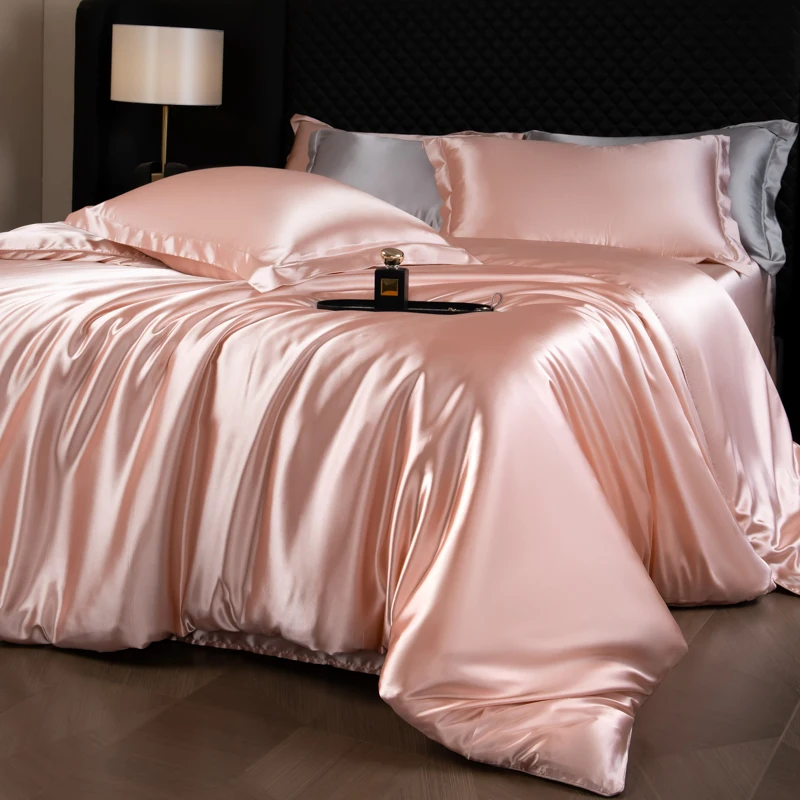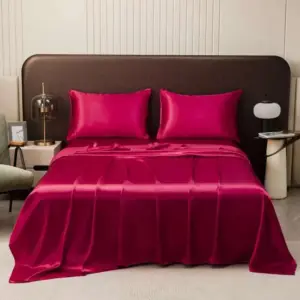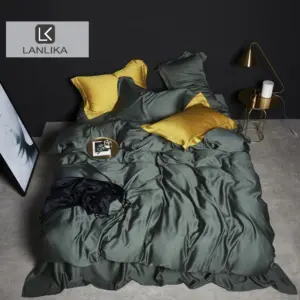Introduction
Shopping for silk products can feel like navigating a maze of unfamiliar terminology, with “momme” perhaps being the most puzzling concept of all. If you’ve ever wondered whether a higher momme count truly means softer silk, you’re not alone. This measurement standard serves as the primary indicator of silk quality and density, but its relationship with softness isn’t always straightforward.
In this comprehensive guide, we’ll unravel the connection between momme weight and silk softness, providing you with practical knowledge to make informed decisions when purchasing silk products. While higher momme generally correlates with softer silk, several other crucial factors contribute significantly to silk’s tactile experience.
Most silk products on the market range from 15 to 30 momme – think of this measurement as similar to thread count for cotton fabrics, but specifically designed to capture the unique properties of silk. Understanding how momme affects the amazing benefits of mulberry silk sheets can dramatically improve your silk shopping experience, whether you’re investing in bedding, clothing, or accessories.
Let’s dive deeper into understanding momme weight and discover what truly determines how soft your silk will feel.
What is Momme Weight in Silk?
Momme (pronounced “moh-mee”) is the standard measurement used to determine silk fabric quality and density. Specifically, it measures the weight in pounds of a piece of silk fabric measuring 45 inches by 100 yards, which is approximately 4.340 grams per square meter. This technical measurement directly reflects how much silk material is present in the fabric.
Unlike cotton and other fabrics that rely on thread count, silk quality is primarily assessed through momme weight. This is because momme provides a more accurate representation than thread count for silk, as it accounts for both the density and weight of the material. In simple terms, the higher the momme, the more silk is used per square inch, resulting in a heavier, denser fabric.
Understanding what momme means in silk is essential for making informed purchasing decisions. The typical momme range available in the market includes:
- 16-19mm: Lightweight silk ideal for scarves, summer garments, and basic bedding
- 19-22mm: Standard range for quality bedding and mid-range garments
- 22-25mm: Premium bedding, luxury apparel, and high-end products
- 25mm+: Ultra-luxury items and specialized applications where maximum density is desired
The momme weight directly correlates to physical properties like thickness, durability, and opacity. A higher momme silk will generally have better insulation properties and greater resistance to wear and tear, while lower momme silk tends to be more breathable and fluid in movement.
The Direct Relationship: Higher Momme and Silk Softness
When we consider how momme affects silk softness, several physical properties come into play that explain why higher momme silk generally feels softer to the touch.
Surface Smoothness
Higher momme silk contains more silk threads packed into the same space, creating a denser weave with fewer gaps between threads. This increased density creates a smoother surface that feels softer against the skin. When you run your hand across 25mm silk versus 19mm silk, the difference is often immediately noticeable – the heavier fabric provides a more continuous surface for your fingers to glide across.
Luxurious Weight and Drape
The substantial feel of higher momme silk contributes significantly to its perceived softness. The weight creates a natural draping effect that conforms to surfaces (whether it’s your bed or body) more completely. This enhanced drape allows the fabric to flow and move in a way that feels luxurious and soft rather than stiff or rigid.
Refined Production Techniques
Manufacturers typically reserve their finest raw materials and most careful processing methods for higher momme products. These good momme ratings for silk require more silk and more labor to produce, so brands are incentivized to ensure the final product meets premium standards. This often means additional refinement steps that enhance the natural softness of the material.
Consistent Softness Over Time
Perhaps most importantly, higher quality silk maintains softness through repeated use and washing. The structural integrity of denser silk (22-25mm) means it’s less likely to develop rough patches or thin areas that diminish its soft feel. While 19mm silk might feel adequately soft initially, 25mm silk often maintains its softness for years rather than months.
When comparing a 19mm silk pillowcase to a 25mm one, most users report that while both feel soft at first touch, the difference becomes more pronounced over time. The 25mm retains its plush feel even after dozens of washes, while the lighter-weight option may begin to lose some of its initial softness.
Physical Properties: How Momme Creates Tactile Differences
To truly understand why momme weight affects softness, we need to look at silk’s structure at the microscopic level. Silk fibers are naturally smooth protein filaments, and their arrangement within the fabric significantly impacts how we perceive their softness.
In higher momme silk, these protein filaments are more densely packed. This microscopic arrangement means there are fewer “gaps” or spaces between the threads. When you touch fabric with minimal gaps, your skin registers a smoother, more continuous surface. Think of it like walking across a floor – a solid surface feels smoother than one with small spaces between boards.
The increased silk protein (fibroin) content in heavier fabrics also contributes to softness. Fibroin naturally has a smooth molecular structure, so having more of it per square inch translates to a silkier feel. Pure silk composition maximizes this natural softness potential, especially at higher momme weights.
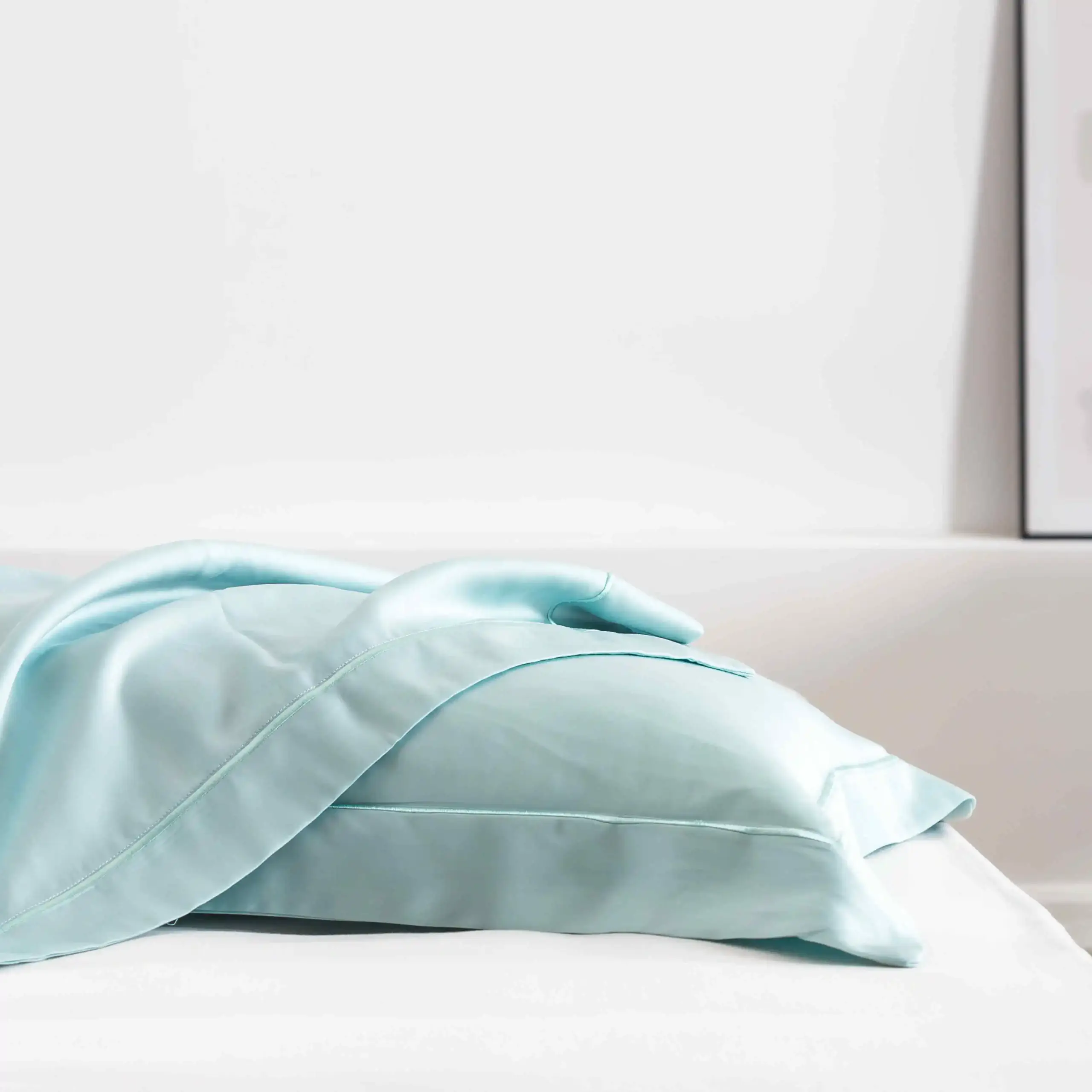
Fabric density also directly impacts how silk interacts with your skin’s moisture and temperature. Higher momme silk (22-25mm) offers enhanced:
- Temperature regulation that prevents clamminess
- Moisture-wicking that maintains a dry surface feel
- Heat distribution that prevents hot spots
These factors may not seem directly related to softness, but they dramatically impact the perceived comfort of the fabric against your skin. A fabric that stays cool and dry will consistently feel softer than one that becomes damp or hot, regardless of its technical specifications.
Higher momme silk also demonstrates superior structural recovery – it bounces back to its original shape after being compressed. This resilience means the fabric maintains its intended surface texture rather than becoming flattened or compressed with use, preserving its soft feel over hundreds of uses.
Beyond Momme: Other Factors That Affect Silk Softness
While momme weight significantly influences silk softness, several other factors play crucial roles in determining the overall tactile experience of silk fabric.
Silk Grade and Fiber Quality
The quality of raw silk fibers used in production dramatically impacts the final product’s softness, regardless of momme weight. Measuring silk quality involves assessing:
- Fiber Length: Longer silk fibers create fewer joins in the thread, resulting in a smoother surface. Premium silks use fibers that can extend continuously for hundreds of meters.
- Uniformity: Even, consistent fibers create a more regular surface texture that feels softer to the touch.
- Purity: Higher-grade silk (such as 6A grade) contains fewer imperfections, knots, or irregular elements that might create rough spots.
A 19mm fabric made with superior grade silk can potentially feel softer than a 25mm fabric made with lower-grade raw materials.
Weave Type
The pattern in which silk threads interlace significantly affects texture:
- Charmeuse: Features a satin weave on one side and a crepe weave on the reverse, creating a fabric with exceptional drape and a smooth, lustrous surface that feels particularly soft.
- Habotai: A plain weave that produces lightweight silk with a soft but more structured feel.
- Crepe: Has a slightly textured surface due to highly twisted threads, offering a different kind of softness with more texture.
Pure mulberry silk in different weave types will each have distinct softness characteristics, even at identical momme weights.
Silk Processing Methods
The journey from cocoon to fabric involves several processing steps that affect softness:
- Degumming: Removes the natural sericin (silk gum) from raw silk. More thorough degumming creates softer fabric but may decrease durability.
- Finishing Treatments: Various softeners, conditioners, or treatments can enhance the initial softness, though these effects may diminish after washing.
- Dyeing Process: Some dye methods preserve the natural softness of silk better than others, particularly when natural dyes or low-impact methods are used.
Silk Purity
The composition of the fabric itself matters tremendously:
- 100% pure mulberry silk will have a distinctly different feel than silk blends
- Wild silk varieties (like tussah) naturally have a different texture than cultivated mulberry silk
- Any synthetic additions or treatments can significantly alter the hand-feel
A 22mm pure mulberry silk sheet typically offers a noticeably softer feel than a 25mm silk-blend product, highlighting how composition can sometimes outweigh momme in determining softness.
The Optimal Momme Range for Maximum Softness
After considering the complex relationship between momme and softness, you might wonder: what’s the ideal momme weight if softness is your priority? Based on extensive industry experience and customer feedback, the sweet spot typically falls within the 22-25mm range for bedding and items that contact the skin directly.
This range represents an optimal balance where:
- The fabric contains enough silk to achieve maximum density benefits
- The threads are substantial enough to create a smooth, continuous surface
- The weight creates ideal draping characteristics that enhance perceived softness
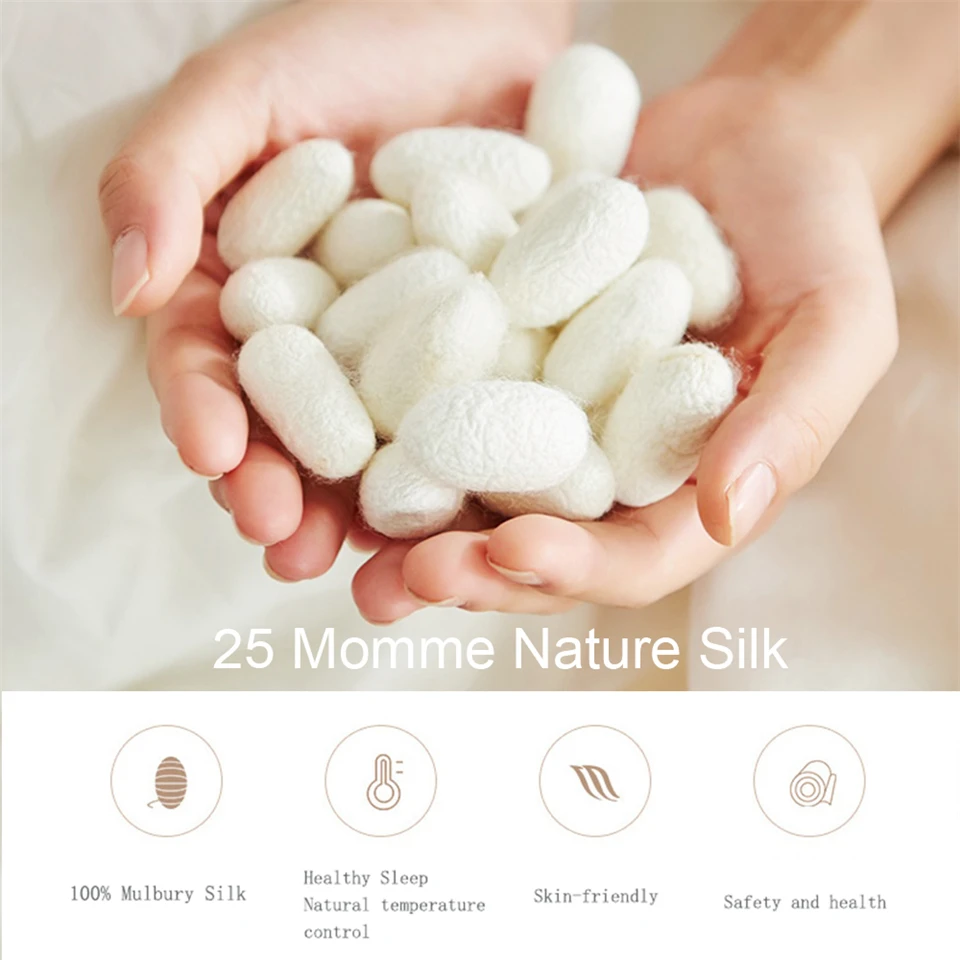
Interestingly, extremely high momme weights (30mm+) don’t necessarily translate to proportionally increased softness. At a certain point, the fabric may become too heavy or rigid to maintain the fluid, supple characteristics that contribute to silk’s signature soft feel.
When choosing the right momme for silk sheets, consider these application-specific recommendations:
- Pillowcases: 19-22mm offers an ideal balance of softness and breathability where your face directly contacts the fabric
- Sheets: 22-25mm provides optimal softness with adequate durability for regular use
- Duvet Covers: 22-25mm offers luxurious drape and substantial feel
- Sleepwear: 19-22mm delivers comfort with the right amount of flow and movement
For those seeking truly exceptional softness in premium silk bedding, 25mm silk often represents the pinnacle of tactile luxury without compromising on practical usability.
Finding the Balance: Softness, Durability, and Value
When shopping for silk, it’s important to consider the relationship between initial softness, long-term comfort, durability, and cost. These factors create a complex equation that varies based on your personal priorities.
Initial Softness vs. Long-Term Feel
Lower momme silk (16-19mm) can feel adequately soft when new but typically loses its luxurious feel faster with washing and use. Higher momme options (22-25mm) may represent a better long-term investment if maintaining consistent softness is important to you.
Durability Considerations
Softness and durability often go hand-in-hand with silk, unlike some other fabrics where softness comes at the expense of strength:
- 19mm silk typically lasts 1-2 years with regular use
- 22mm silk often maintains quality for 2-4 years
- 25mm silk can remain in excellent condition for 5+ years with proper care
This extended lifespan makes higher momme silk more economical over time, despite the higher initial investment. Many customers find that transforming sleep quality with a complete silk bedding system justifies the premium price through years of consistent comfort.
Price-Value Assessment
While 19mm silk sheets might cost 30-40% less than their 25mm counterparts, the higher-momme option typically offers:
– 2-3 times longer lifespan
– Sustained softness through hundreds of uses
– Better resistance to pilling and wear
– More consistent temperature regulation
For most consumers, the 22mm range represents an excellent compromise between accessibility and quality, while 25mm stands as the premium choice for those prioritizing maximum softness and longevity without concern for budget.
Full-size Silk Sheets, King Size Silk Sheets, Queen Size Silk Sheets, Twin Size Silk Sheets, Washable Silk Sheets
Price range: $95.95 through $178.37 Select options This product has multiple variants. The options may be chosen on the product page100% Silk Sheets, Green Silk Sheets, King Size Silk Bedding Set, Mulberry Silk Bedding Sets, Queen Size Silk Bedding Set
Price range: $1,246.21 through $1,615.22 Select options This product has multiple variants. The options may be chosen on the product pagePink Silk Sheets, Twin Size Silk Sheets
$171.80 Select options This product has multiple variants. The options may be chosen on the product pageFull-size Silk Sheets, Pink Silk Sheets
$136.31 Select options This product has multiple variants. The options may be chosen on the product pageGrey Silk Sheets, Silk Sheet and Pillowcase Set
Price range: $88.20 through $146.64 Select options This product has multiple variants. The options may be chosen on the product pageBamboo Silk Sheets, Cooling Silk Sheets
Price range: $130.76 through $177.80 Select options This product has multiple variants. The options may be chosen on the product page
When evaluating silk products, consider not just the cost per purchase, but the cost per night of use – this perspective often reveals higher momme silk as the better value despite its premium price.
How to Test and Verify Silk Softness Before Purchasing
Assessing silk softness can be challenging, especially when shopping online. Here are practical methods to evaluate silk quality and softness:
In-Person Assessment Techniques
When you can physically interact with silk:
- Fingertip Test: Gently run your fingertips across the surface – high-quality silk should feel consistently smooth without rough patches.
- Scrunch Test: Gather the fabric in your hand and then release it. Quality silk will bounce back quickly without excessive wrinkling.
- Visual Inspection: Look for even color distribution and a subtle, consistent sheen rather than an artificial-looking shine.
- Temperature Feel: Quality silk should feel cool to the initial touch but quickly warm to body temperature.
Online Shopping Strategies
When purchasing silk remotely:
- Specific Terminology: Look for descriptive language like “buttery,” “smooth drape,” or “fluid hand” rather than vague terms like “luxurious” or “premium.”
- Quality Certifications: Check for mentions of fiber grade (6A is top quality) and production standards.
- Customer Reviews: Pay special attention to comments specifically addressing softness and how it changes after washing.
When exploring quality silk products online, detailed product descriptions that specify both momme weight and fabric composition are essential. Reputable retailers like Sanctuary Soft provide comprehensive information about their silk sheets to help customers make informed decisions.
A good return policy is especially important when buying silk online, as softness is such a personal perception. Look for brands that stand behind their products with customer-friendly policies that allow you to experience the fabric firsthand.
Common Misconceptions About Momme and Silk Softness
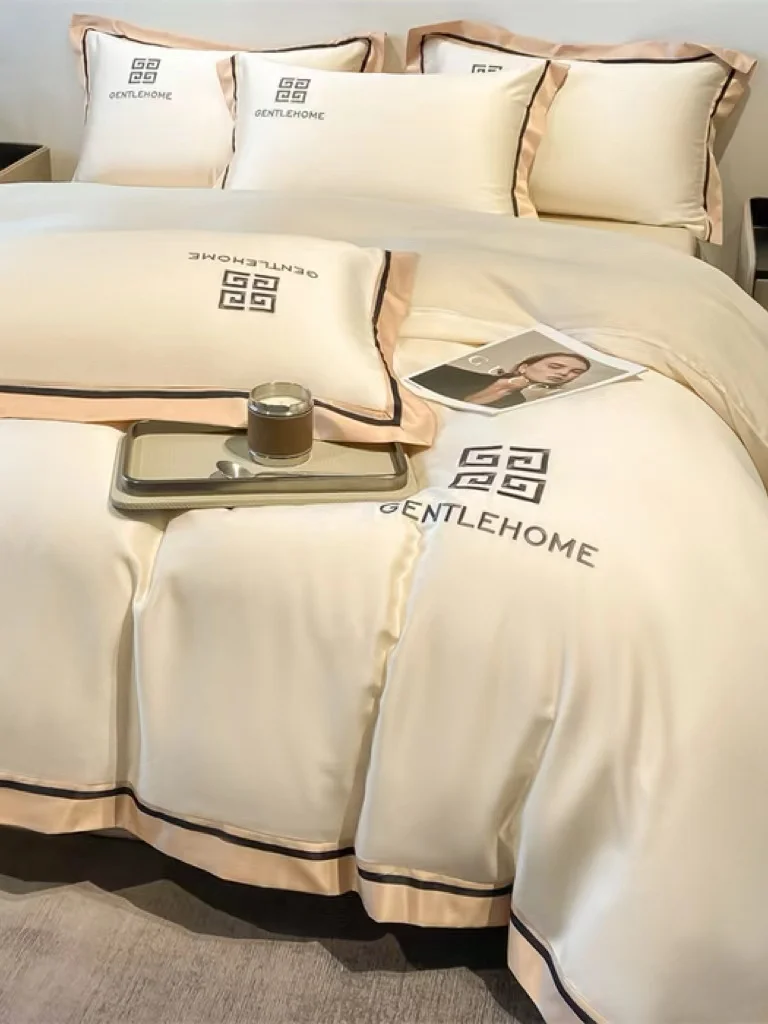
Several persistent myths surround silk softness and momme weight. Let’s address these misconceptions to provide clarity:
Myth: Higher Momme Always Means Softer Silk
Reality: While there’s a general correlation between higher momme and increased softness, this relationship isn’t absolute. A well-processed 19mm silk with superior fiber quality might feel softer than a poorly produced 25mm silk. The relationship is strong but not guaranteed without considering other quality factors.
Myth: Thread Count Matters for Silk Quality
Reality: Thread count is largely irrelevant for silk. Unlike cotton, silk quality is properly measured in momme weight. Companies that prominently advertise thread count for silk products may be attempting to apply cotton-fabric marketing to silk inappropriately.
Myth: All Silk Feels The Same Regardless of Momme
Reality: There are significant tactile differences between different momme weights. In blind tests, most people can readily distinguish between 19mm and 25mm silk based on feel alone, with the higher momme consistently rated as having a more substantial, luxurious hand-feel.
Myth: Silk Softness Is Purely Subjective
Reality: While personal preference plays a role, there are objective components to silk softness. Density, fiber quality, weave uniformity, and processing methods create measurable differences in surface smoothness and tactile properties.
Myth: Softness Means Fragility
Reality: With silk, increased softness often correlates with increased durability, not decreased. Higher momme silk (22-25mm) typically offers both enhanced softness and superior longevity, making it an excellent investment for those choosing mulberry silk sheets for their bedding.
Understanding these realities helps consumers make more informed decisions when evaluating silk products and prevents disappointment from misaligned expectations.
Maintaining Silk Softness: Care Tips for Different Momme Weights
Proper care is essential for maintaining the softness of silk regardless of momme weight, though different weights may require slightly different approaches:
Washing Guidelines
- Light Momme (16-19mm):
- Hand washing is strongly recommended
- Use cool water (30°C/86°F maximum)
- Gentle silk-specific detergent in minimal amounts
Avoid soaking for more than 5 minutes
Medium to Heavy Momme (22-25mm):
- May tolerate gentle machine washing in mesh bags
- Use silk-specific cycle if available
- Cool water is still recommended
- Can withstand slightly more frequent washing
Drying and Storage
- Allow silk to air dry by laying flat on a towel
- Keep away from direct sunlight which can damage fibers
- Store folded with acid-free tissue paper between folds
- Avoid hanging lighter momme silk which may stretch over time
The skin benefits of mulberry silk bedding are best preserved when the fabric maintains its original softness and structure. Higher momme silk (22-25mm) typically withstands more wash cycles before showing signs of wear, making it particularly valuable for items that require frequent laundering.
Environmental factors like humidity, sunlight exposure, and contact with skin oils or products can affect silk’s feel over time. Using a humidifier in dry environments and keeping silk away from direct sunlight can help maintain its luxurious softness regardless of momme weight.
Conclusion: Making the Right Silk Choice for Your Needs
The relationship between momme weight and silk softness is nuanced but significant. While higher momme generally correlates with a softer, more luxurious feel, multiple factors including fiber quality, weave type, and processing methods contribute to the overall tactile experience.
For most consumers seeking an optimal balance of immediate softness, long-term comfort, and reasonable durability, the 22-25mm range represents the sweet spot for silk products, particularly bedding. This range offers the density needed for that truly smooth, continuous surface that defines luxury silk while remaining practical for everyday use.
However, your individual preferences and priorities should guide your final decision:
- If maximum immediate softness is your priority: Look for 22-25mm charmeuse silk with high-grade fibers
- If balanced softness and durability matter most: 22mm silk offers excellent value with very good softness
- If long-term investment in quality is your focus: 25mm silk typically provides the best longevity while maintaining exceptional softness
Quality silk is an investment in comfort that pays dividends night after night. Whether you’re shopping for silk pillowcases or complete bedding sets, understanding how momme affects softness empowers you to make choices aligned with your personal preferences and practical needs.

